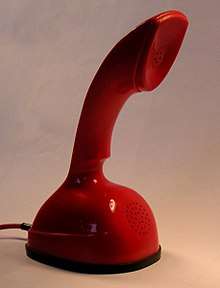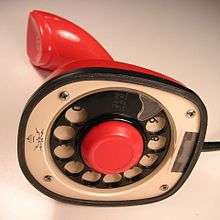Ericofon
The Ericofon is a one-piece plastic telephone created by the Ericsson Company of Sweden and marketed through the second half of the 20th century. It was the first commercially marketed telephone to incorporate the dial and handset into a single unit. Because of its styling and its influence on future telephone design, the Ericofon is considered one of the most significant industrial designs of the 20th century by Phaidon.[1] It is in the collection of the Museum of Modern Art in New York City. In Sweden, the Ericofon is known as the cobra telephone for its resemblance to a coiled snake.[2]


History
The Ericofon was designed in the late 1940s by a design team including Gösta Thames, Ralph Lysell, and Hugo Blomberg.[3] The two major components of the telephone, the handset and the dial, are combined in a single unit. This one-piece design anticipated the evolution of the typical cordless phone and cell phone by several decades. Serial production began in 1954. Early models were sold only to institutions, but in 1956 production for the open market began in Europe and Australia.
As the Bell System did not permit the operation of third-party equipment on their network, the Ericofon could only be used by independent telephone companies in the United States. North Electric in Galion, Ohio, manufactured the Ericofon for the North American independent market.
Design
The original phone was produced in two slightly different designs. The earliest version is slightly taller, with the earpiece at nearly a 90-degree angle to the base. A later version has a shorter handle, with the earpiece angled slightly downward. The two versions are referred to as the old case and the new case. The old case was molded in two pieces, while the new case was molded as a single piece. Both versions were initially produced in 18 colors. They used the four-prong plug common in the United States at the time.
A third version, the model 700, was produced beginning in 1976. It is easily distinguished from earlier Ericofons by its squarish design, as well as changes to the handle and plug.
Colors
When it was introduced on the U.S. market, the Ericofon was available in 18 colors, but after transfer of production to North Electric, the number of colors was reduced to eight. A small number of phones with clear and metallic finishes were produced for special promotions. The most popular and widely produced colors were bright red and bright white. Other colors included various pastel shades of blue, green, and pink. The phone was never produced in black.
Ericotone
Most Ericofons had mechanical rotary dials, typical of all phones made in the era. While Ericofons produced by Ericsson used miniature buzzers as ringers, North Electric introduced the electronic "Ericotone" ringer. The Ericotone ringer used a simple, one-transistor oscillator circuit to produce a distinctive "chirping" sound. This was one of the earliest uses of a transistor in a telephone; telephones with mechanical bell ringers and rotary dials did not need transistors.
Touch-tone
North Electric introduced a touch-tone version of the Ericofon in the United States in 1967. Production of this variant was much lower than that of the rotary-dial Ericofons. A design flaw in the hook switch mechanism can cause the touch-tone version of the phone to become unusable if it is set down too forcibly. North Electric ceased production of the Ericofon for North America in 1972.
Ericsson introduced a push-button version of the Ericofon, the model 700, for the company's 100th anniversary in 1976. The model 700 had a squarer design than earlier models. It was not a touch-tone phone. Instead, its electronics generated electrical pulses as its buttons were pressed, simulating the pulses produced by a rotary dial. Ericsson continued to produce rotary-dial Ericofons until about 1980.
Recent production
Wild and Wolf produces an Ericofon-lookalike called "Scandiphone".[4] The modern touch-tone phone is available in several colors and can be bought from web stores.
Media appearances
The Ericofon has been seen in several feature films and TV shows, mostly in the 1960s and 1970s.
- An Ericofon appears prominently in The Twilight Zone episode "Third from the Sun", first broadcast on January 8, 1960; and is also in the episode "One More Pallbearer".
- A white Ericofon can be seen on the office desk of the supervillain in the movie Banco à Bangkok pour OSS 117 (1964).
- An Ericofon appears briefly in the headquarters of the enemy in the first episode "Eleven Days to Zero" (1964) of the TV series Voyage to the Bottom of the Sea.
- In the movie The World of Henry Orient (1964), Peter Sellers uses an Ericofon in his bedroom.
- Ericofons were used for several years in the detectives' office in the Australian TV series Homicide, with the phone listed by name in episode credits, and L.M Ericsson as the supplier.
- Red, white, and beige Ericofons appear throughout the underground research headquarters in "Crack in the World" (1965).
- I'll Take Sweden (1965) Starring Bob Hope and Frankie Avalon.
- An Ericofon is featured in the opening scene in In Like Flint (1967).
- In the movie Two for The Road (1967), architect Mark Wallace (Albert Finney) receives a long-distance call at a housewarming party on an Ericofon.
- In the 1967 film Casino Royale, Le Chiffre (Orson Welles) receives a phone call from SMERSH on an Ericofon.
- In the 1969–1972 television series The Courtship of Eddie's Father, the Corbett household has an Ericofon.
- In "Doomsday" (1969), the seventeenth episode of the third season of Mission: Impossible, Jim Phelps (Peter Graves) uses a white Ericofon. In the following episode, "Live Bait", an Ericofon is the desk phone of Helmut Kellermann (Anthony Zerbe), the episode's main antagonist.
- A red Ericofon is used in a top-security U.S. tracking station in the episode "The Ninety-Second War: Part II" (1972) of the TV series Hawaii Five-O.
- An Ericofon is seen in the operation room of the secret service in the French movie Le grand blond avec une chaussure noire (1972).
- An Ericofon can be seen on a table in a scene from the 1973 film Theatre of Blood.
- Many Ericofons are used in the French adult comedy Young Casanova (1974).
- Ericofons are used in the Norvegian adult comedy Kosmetikkrevolusjonen (1977).
- There is a red Ericofon on Higgins' desk, in the episode "China Doll" (1980) of the TV series Magnum, P.I.
- A yellow Ericofon is placed on a table in the living room in the 1980 movie Sunday Lovers.
- Dominique Lavanant uses a red Ericofon in La boum, a 1980 French movie starring Sophie Marceau.
- Doris Roberts is seen speaking into a white Ericofon in the opening credits of Remington Steele (1982-1987).
- An Ericofon is used by Stella in the 1986 Icelandic movie Stella í orlofi.
- The character Myra Gale Brown (played by Winona Ryder) uses an Ericofon in a few scenes of Great Balls Of Fire! (1989).
- The character Teddy Forzman in the TV show The Adventures of Pete & Pete (1993–1996) uses an Ericofon in the third-season episode "The Trouble with Teddy."
- Ericofons were featured in the 1997 movie Men in Black. They were the desk phones at workstations at headquarters.
- A modified Ericofon appeared as a prop alien telephone in the first-season episode "I, E.T." of the TV series Farscape (1999–2003).
- A character in the 1999 film But I'm a Cheerleader uses a green Ericofon.
- In the French TV movie L'affaire Ben Barka (2007), a white Ericofon is used in an office of the Paris-Orly Airport. The action takes place in 1965.
- In Mad Men (2007–2012), Roger Sterling uses an Ericofon in his new office. The action is set in the 1960s.
- In the Argentinian movie El Secreto De Sus Ojos from 2009 an Ericofon is used. The scene is dated in the mid seventies.
- In the episode "There Is Another Sky" (2010) of the TV series Caprica, Joseph Adama receives a call on an Ericofon.
- In the Dutch movie "The kidnapping of Freddy Heineken" (2011), a red Ericofon was used. The story plays in 1983.
- In the 2015 film The Man from U.N.C.L.E., Victoria Vinciguerra is briefly seen speaking on an aqua mist colored Ericofon.
See also
References
- https://www.phaidon.com/designclassics Vol. 2, Item 437
- The "Cobra" – named by the Swedish people
- Snake-charming
- "Archived copy". Archived from the original on 2017-05-02. Retrieved 2013-10-30.CS1 maint: archived copy as title (link)